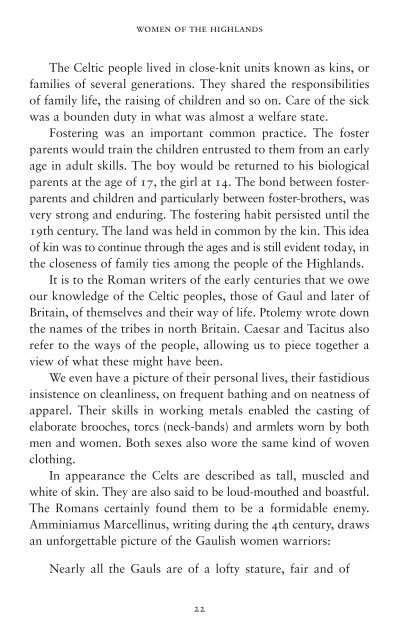Women of the Highlands by Katharine Stewart sampler
What was the crime of the last wich burnt in the Highlands? Which Jacobite lady led men to war while her Hanoverian husband stayed at home? Who were the first Highland women to be recorded in history? And how have wome's lives changed since medieval times? Katharine Stewart takes us to the heart of the Highlands in her history of the women who shaped this land and handed down the legends which have provided a rich vein of material for generations. From the women of the shielings to ladies at court, from bards to conservationists, authors to folk-singers, Women of the Highlands examines how the culture of the Highlands was created and passed down through the centuries, and how the tradition is continuing today.
What was the crime of the last wich burnt in the Highlands?
Which Jacobite lady led men to war while her Hanoverian husband stayed at home?
Who were the first Highland women to be recorded in history?
And how have wome's lives changed since medieval times?
Katharine Stewart takes us to the heart of the Highlands in her history of the women who shaped this land and handed down the legends which have provided a rich vein of material for generations. From the women of the shielings to ladies at court, from bards to conservationists, authors to folk-singers, Women of the Highlands examines how the culture of the Highlands was created and passed down through the centuries, and how the tradition is continuing today.
Create successful ePaper yourself
Turn your PDF publications into a flip-book with our unique Google optimized e-Paper software.
women <strong>of</strong> <strong>the</strong> highlands<br />
The Celtic people lived in close-knit units known as kins, or<br />
families <strong>of</strong> several generations. They shared <strong>the</strong> responsibilities<br />
<strong>of</strong> family life, <strong>the</strong> raising <strong>of</strong> children and so on. Care <strong>of</strong> <strong>the</strong> sick<br />
was a bounden duty in what was almost a welfare state.<br />
Fostering was an important common practice. The foster<br />
parents would train <strong>the</strong> children entrusted to <strong>the</strong>m from an early<br />
age in adult skills. The boy would be returned to his biological<br />
parents at <strong>the</strong> age <strong>of</strong> 17, <strong>the</strong> girl at 14. The bond between fosterparents<br />
and children and particularly between foster-bro<strong>the</strong>rs, was<br />
very strong and enduring. The fostering habit persisted until <strong>the</strong><br />
19th century. The land was held in common <strong>by</strong> <strong>the</strong> kin. This idea<br />
<strong>of</strong> kin was to continue through <strong>the</strong> ages and is still evident today, in<br />
<strong>the</strong> closeness <strong>of</strong> family ties among <strong>the</strong> people <strong>of</strong> <strong>the</strong> <strong>Highlands</strong>.<br />
It is to <strong>the</strong> Roman writers <strong>of</strong> <strong>the</strong> early centuries that we owe<br />
our knowledge <strong>of</strong> <strong>the</strong> Celtic peoples, those <strong>of</strong> Gaul and later <strong>of</strong><br />
Britain, <strong>of</strong> <strong>the</strong>mselves and <strong>the</strong>ir way <strong>of</strong> life. Ptolemy wrote down<br />
<strong>the</strong> names <strong>of</strong> <strong>the</strong> tribes in north Britain. Caesar and Tacitus also<br />
refer to <strong>the</strong> ways <strong>of</strong> <strong>the</strong> people, allowing us to piece toge<strong>the</strong>r a<br />
view <strong>of</strong> what <strong>the</strong>se might have been.<br />
We even have a picture <strong>of</strong> <strong>the</strong>ir personal lives, <strong>the</strong>ir fastidious<br />
insistence on cleanliness, on frequent bathing and on neatness <strong>of</strong><br />
apparel. Their skills in working metals enabled <strong>the</strong> casting <strong>of</strong><br />
elaborate brooches, torcs (neck-bands) and armlets worn <strong>by</strong> both<br />
men and women. Both sexes also wore <strong>the</strong> same kind <strong>of</strong> woven<br />
clothing.<br />
In appearance <strong>the</strong> Celts are described as tall, muscled and<br />
white <strong>of</strong> skin. They are also said to be loud-mou<strong>the</strong>d and boastful.<br />
The Romans certainly found <strong>the</strong>m to be a formidable enemy.<br />
Amminiamus Marcellinus, writing during <strong>the</strong> 4th century, draws<br />
an unforgettable picture <strong>of</strong> <strong>the</strong> Gaulish women warriors:<br />
Nearly all <strong>the</strong> Gauls are <strong>of</strong> a l<strong>of</strong>ty stature, fair and <strong>of</strong><br />
22


















